Dinger's Aviation Pages
AIRCRAFT OF THE FIGHTING POWERS
A few notes for book collectors and aeromodellers from information provided by Adrian Lee, Ian Black and a kind donation by James Easton.
Last revised, January 2025.
A few notes for book collectors and aeromodellers from information provided by Adrian Lee, Ian Black and a kind donation by James Easton.
Last revised, January 2025.
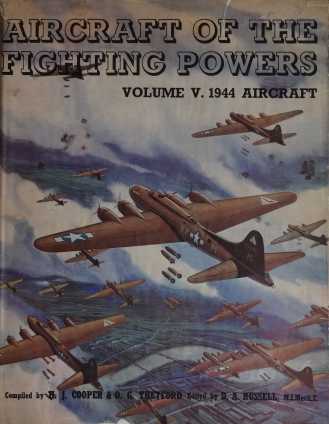
Dust-jacket cover of the original Volume 5.
The dark days of 1940 saw the start of an extraordinary series of books. "Aircraft of the Fighting Powers" was designed to describe the major combat aircraft of the warring countries along with a three-view diagram of each aircraft in a constant scale (1/72 scale). This made it a vital reference, not only for recognising aircraft but also for building model aircraft. Models were an invaluable aid for aircraft recognition. The crew rooms of RAF stations, AA gun sites and Observer Corp posts would have their ceilings festooned with model aircraft, carved from wood, hanging from threads.
The title first appeared in 1940 and covered 87 aircraft in service at the start of the war. It had an earlier, cheaper "softback" version called "Scale Plans of Military Aircraft" by CAH Pollitt. They shared the same, initially quite crude, diagrams of aircraft but the softback version only had 39 aircraft. The first edition of "Aircraft of the Fighting Powers" had all the fold-out double-page plans of larger aircraft at the back of the book, with only a single three-page fold-out plan (the Consolidated Type 28-5 flying boat better known as the "Catalina").
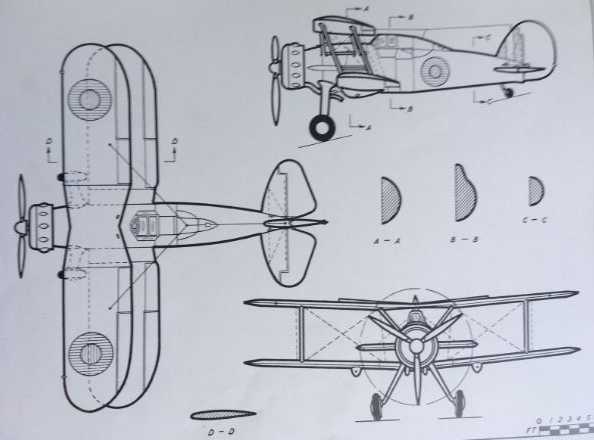
The earlier, less-detailed, drawing of the Gladiator common to the very first printing of "Aircraft of the Fighting Powers" and "Scale Plans of Military Aircraft".
Of course, the war didn't end in 1940, and new aircraft quickly came into service and other nations joined the conflict. So it was decided to issue a new volume in December each year. The plans in "Volume 2" and subsequent volumes were drawn to a much higher standard than the initial first book. The format was changed to have the aircraft grouped by country of origin. It eventually ran to seven volumes (the release date of Volume 7 was brought forward to March 1947). Some aircraft remained in service for many years, so the older volumes were kept in print and the original 1940 edition of the book was updated to be called "Volume 1" and had the plans updated to the new, higher standard.
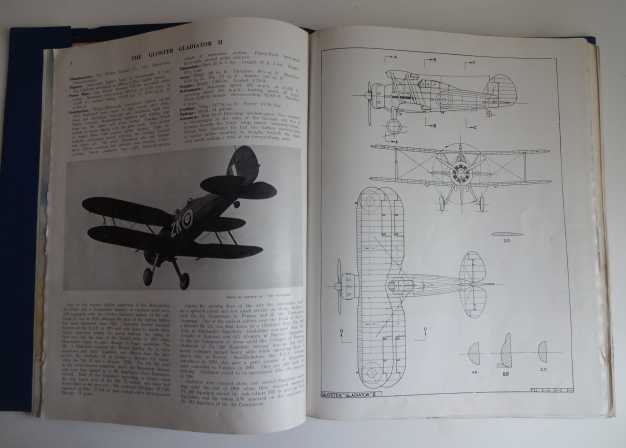
The first aircraft in the second version of the first volume was the Gloster Gladiator (in the earlier version the first aircraft listed was the Fairey Fulmar).
The early format has just "Aircraft of the Fighting Powers" on the spine, while the later version adds "Volume 1". The earlier version is purely black and white, with no colour plates or use of colour in the adverts. The diagrams in the early edition are done in a simpler, less detailed, format, identical to those in the early "Scale Plans of Military Aircraft" and the list of aircraft covered is different in the two versions. The early version does not feature the Henschel HS123, Bloch 151 or Handley Page Harrow, it does have the Curtiss P40 Tomahawk, Bell Airacobra and Consolidated 28-5 Catalina which do not appear until volume 2 of the later editions. The early version features the Martin Baltimore bomber while the later version has the Martin Maryland bomber in its place, the Baltimore then reappears in volume 2. In the early version, the Junkers Ju 90 transport aircraft is listed under the development name of Junkers Ju 89k. Three versions of dust jacket were used for Volume 1. The first had a comic-like representation of a Spitfire shooting down a Heinkel HeIII. The second was very similar but had added detail to the background landscape with "Volume 1" added to the title. The last version had a painting of Bristol Blenheims taking off.
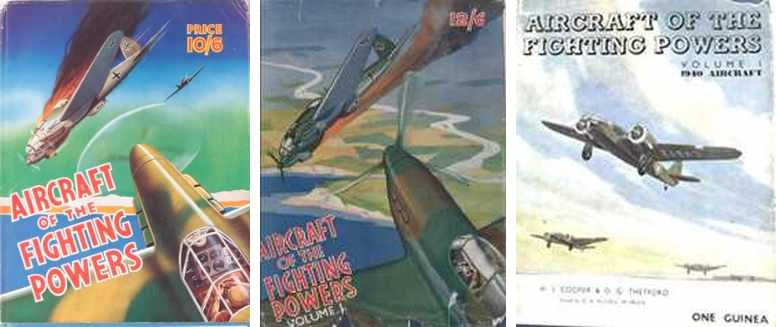
The three different versions of cover for Volume 1. Note the doubling of price from 10/6 to one guinea
Produced by the Harborough Publishing Company of Leicester, which specialised in books for aircraft modellers, the work was overseen by Douglas Arthur Russell, owner of the company. The text was written by a young Owen G Thetford (who could have been only 17 years old when the project started) who went on to have a long and distinguished career as an aeronautical writer. Up until volume 5, the aircraft plans were done by Harry J Cooper, those for volume 6 were done by C.B. Maycock and those for volume 7 by E J "Eddie" Riding. The dustjackets and frontispieces were painted by C Rupert Moore A.R.C.A. (Associate of the Royal College of Art).
The books were a lavish production, seemingly not constrained by the paper-rationing then in force. Larger aircraft required "fold-out" plans, some of two pages but really large designs required three. There were colour plates, each book usually had at least one plate of a painting of aircraft in flight. The front of each volume also contained pages of advertisements, up to a quarter of each book could be taken up with these. Some of the advertisements featured colour and are often striking works of art. The book covers had embossed lettering and the dust covers were especially vivid and eye-catching.
A few aircraft proved too large to reproduce in 1/72 scale, even on three-page fold-outs, and so had to be represented in 1/144 scale instead. These include the Boeing C98 "Clipper" in Volume 5, the Boeing B29 Superfortress, C-97 Stratocruiser, Short Shetland and Kawanishi Emily in Volume 6 and the Avro Lincoln, Handley Page Hastings, Short Seaford, B-32 Dominator, Martin Mars, Douglas Globemaster and PBY2Y Coronado in Volume 7.
Volume 6 unusually contains an additional article on Air Sea Rescue. The photos of the Walrus. Spitfire and Lysander are all the aircraft of 276 Squadron (coded AQ) based at RAF Harrowbeer.
Some aircraft were featured multiple times as they were developed into succeeding marks, for example, the Spitfire appears no less than 11 times. The later volumes featured aircraft that had been taken off the "secret list". For example, the Blackburn B20 appeared in volume 6 in 1945 even though the only example built had crashed in 1940.
Volume 7 featured a handy appendix detailing which volume and page to look up the aircraft featured in all the series. This is appropriate only for the later version of "Volume 1".
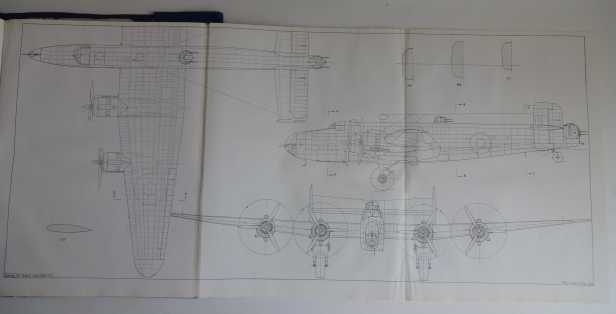
One of the splendid fold-out 3 view diagrams, in this case, the Handley-Page Halifax.
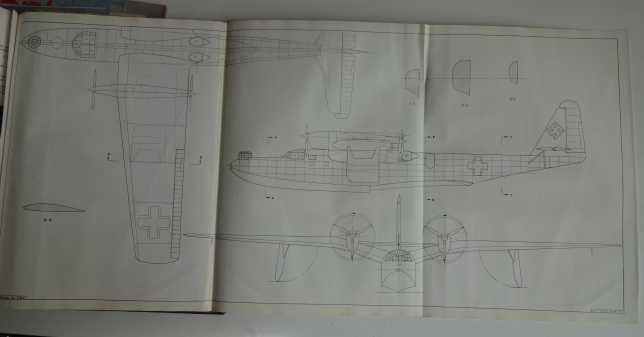
Fold-out plan of the Dornier Do 26 Flying boat from volume 2. By the time this plan appeared, four of the six Do 26 aircraft built had already been destroyed.
One of the things of interest to modern historians is the things they got wrong. Volume 1 features such aircraft as the "propaganda" Heinkel He113 fighter and the "Jaguar" version of the Messerschmitt 110 which never saw service. The descriptions of Russian and Japanese aircraft that started in volume 3 are sometimes way off in both description and illustration. Types that saw little service are given coverage while other types in widespread use are missed out until later volumes. It is particularly evident that the British knew far less about the aircraft of their allies, the Russians, than their enemy, the Luftwaffe. Pearl Harbour came too late for any Japanese aircraft to be included in the 1941 edition.
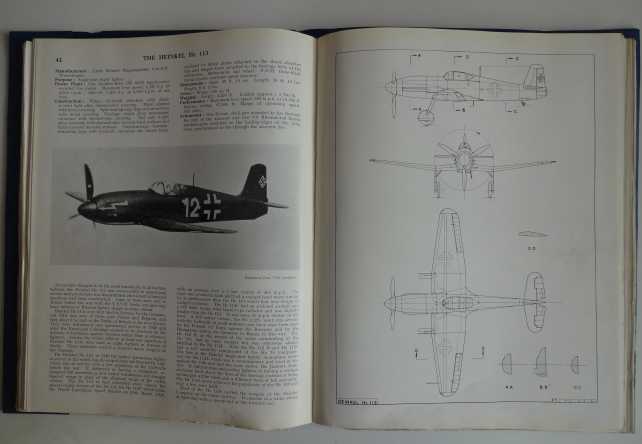
A diagram of the Heinkel 113 (Heinkel 100) with an inaccurate wing profile accompanied the description in Volume 1. Only a few pre-production prototypes were built, which were used briefly as a defence force for the Heinkel factory at Marienehe. The German propaganda ministry had them photographed in numerous settings and guises to make it look as if they were in widespread use. Some British pilots in the Battle of Britain even reported dogfights with Heinkel 113s!
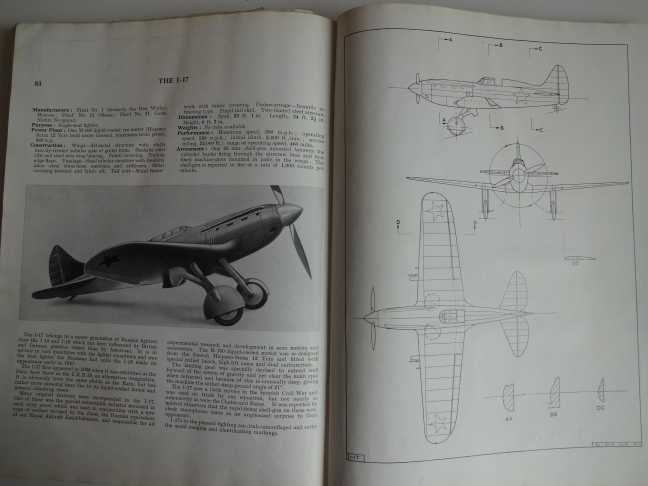
The pages on the Russian I-17 fighter in volume 2. It reported the aircraft to be in service in "vast numbers". In fact, only three prototypes were ever built.
One feature particularly valued by aeromodellers is a page in Volume 5 that shows examples of the then-current RAF camouflage colours.
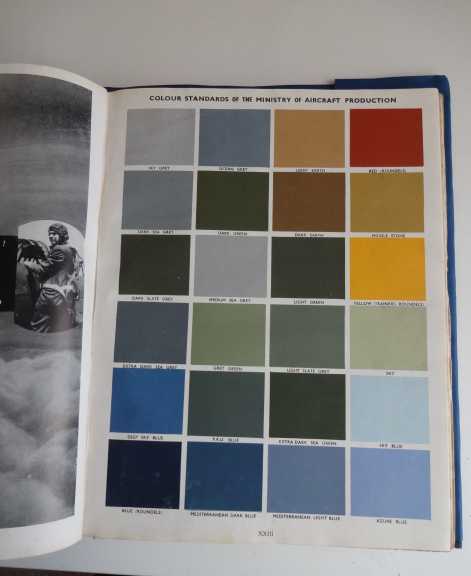
The camouflage colours page from Volume 5.
The sale price of the early version of Volume 1, when it first came out, was 10 shillings and sixpence (52 and a half pence in modern decimalised UK money). This was at a time when a skilled tradesman would earn about 10 pounds a week. So when originally produced each volume would have cost the equivalent of about 30 pounds today (2023). By 1942 the price of volumes had risen to one guinea, which was one pound and one shilling (21 shillings, one pound and five pence in modern decimalised money). The equivalent of 60 pounds today. By the end of the war, the price had gone up to one and a half guineas (31 shillings and sixpence, One pound 58½ pence in decimalised money) something in the order of 90 pounds today. These were not "pocket money" books and their purchase would have been well out of the reach of most schoolchildren and teenagers unless it was given as a special Christmas present (being published in December it was ideal for that). The very fact that they were priced in "guineas" reflects this. Pricing in guineas was usually only done for "high-class" expensive items. Some of the books were likely purchased at a discount by the companies that advertised in it, to be given away by their sales and PR departments.
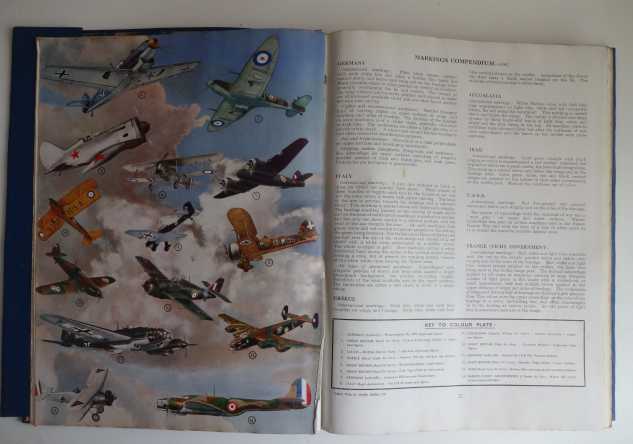
Examples of colour plates, sadly today they often end up as framed prints on Ebay!

Anyone wanting to collect these books needs to understand an important point. The early volumes stayed in print alongside the latest volumes. This means that volumes 1 to 4 are fairly common, as you get to volumes 5, 6 and 7 they become harder to find. This is because fewer of these volumes were produced. They stayed in print for a much shorter period and fewer people bought them because there was less need for them for recognition purposes as the war drew to a close. The increased cost of the later volumes would have also reduced sales.

Covers of volumes 2 to 7. Some adverts for Volume 2 featured a different cover, featuring Boston bombers, it is not known if that cover was ever produced. If you have ever seen or own such a cover please get in touch.
The later impressions of the earlier volumes differed in detail from when they were first published. The impressions seem to have had far fewer advertisements and missed out on the forward if it was no longer appropriate. The text for the aircraft was updated and can vary greatly between the different reprints. In correspondence with Ian Black, who has an extensive collection of the books, he tells me that there can be major differences in plans and adverts even within copies marked as the same impression. For example, different copies of the first impression of Volume 3 have updated plans for the Lancaster and Mosquito. This implies that changes were made "on the fly".
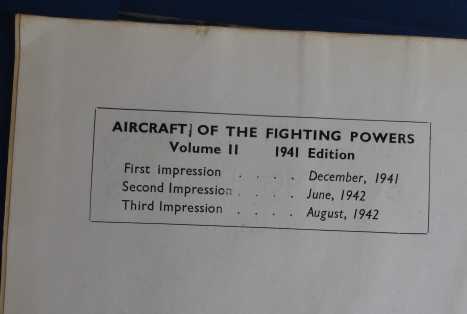
Note of impression numbers of a Volume 2 edition.
The second-hand value of the books reached a peak in the 1960s and 1970s, a classic case of middle-aged people buying items they yearned for in their youth. The rarer volumes 7, 6 and 5 were particularly sought after. In 1977 copies of Volume 7 were being sold for £50, equivalent to £450 in 2023! This trend was noticed and in 1979 the volumes started to be republished by Argus Books. Because of the shortage of the later volumes, they began publishing these reprints in reverse order. I think they only got around to republished volumes 7 and 6. These reprints are nowhere near as desirable to a book collector as the originals. The advertisement pages were deleted, the colour artwork was omitted and the dustjackets were a drab blue design. The worst aspect of these reprints is that the two-page plans were printed on adjacent pages rather than as two-page fold-outs (those 1/72 aircraft plans too big to fit on two pages were still printed on three-page fold-outs). This makes them much less desirable for aeromodellers since the plans do not lie flat.
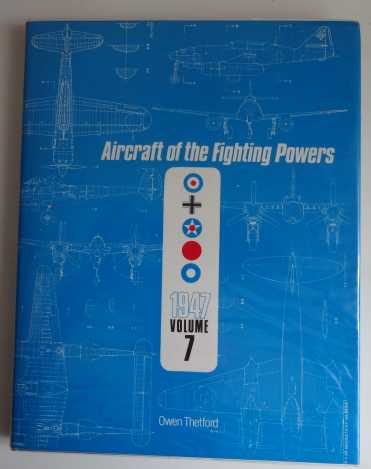
The cover of the reprint of Volume 7, published by Argus Books in 1979.
Because they cost so much to buy, many were kept as treasured possessions and collections can turn up in excellent condition, advertised online or in second-hand bookshops. You need to be careful to check none of the plans have been cut out by enthusiastic model makers. However, the fold-out plans were bound into each volume in such a way that a small "runt" length of paper protrudes from the spine elsewhere in the book; this gives the impression that a page has been cut out whereas, in fact, the book is completely intact (this does not apply to the Argus reprints). In the early version of Volume 1, all the fold-out plans are grouped at the end of the book and the "runt" lengths of paper are thus all bunched together and are much less prominent than in the later version and subsequent volumes where they are spread throughout the volume.

The way the fold-out pages are bound means that part of them protrude between other pages, giving the impression that pages have been cut out.
If you are an aeromodeller only interested in getting accurate plans of smaller, single-engined aircraft that take up only one page, then the Argus reprints of volumes 6 and 7 might be of interest. The plans in these last two volumes are excellent and largely avoid the inaccuracies of the earlier volumes. However, as mentioned earlier, the larger two-page plans are printed on adjacent pages and do not lie flat.
If you are a book collector, then the ultimate find would be a collection of well-kept first impressions of the full seven original volumes in their original dustjackets. A true collector might also want to have both versions of Volume one. It is sad to see the dismembered contents of some volumes turn up on eBay as mounted prints, it is always best to see them kept intact whenever possible.
Having amassed this huge resource of scale diagrams of aircraft it was only natural that they should be made use of in further publications. Adrian Lee has given me an excellent rundown of the titles he is aware of:
Scale Plans of Military Aircraft, the predecessor to "Aircraft of the Fighting Powers", continued to be printed. From the 6th edition in June 1942, the scale drawings were updated to be more detailed, but not quite to the higher standard of Aircraft of the Fighting Powers. The plans and text were more geared to model builders than aircraft recognition. Being in a magazine format it sold for less than a quarter of the price of the hardback, "Aircraft of the Fighting Powers". It did feature two-page fold-out plans of some larger twin-engines types but did not feature any larger four-engined designs. It stopped being attributed to CAH Pollitt, instead, the authorship was given as being compiled by “The Aeromodeller staff”. There was another softback title from Harborough called "Solid Scale Model Aircraft", the bulk of which was made up of instructions on how to go about carving model aircraft from wood. It had four of the plans from "Scale Plans of Military Aircraft" included, the Hurricane, Spitfire, Defiant and Heinkel He111.
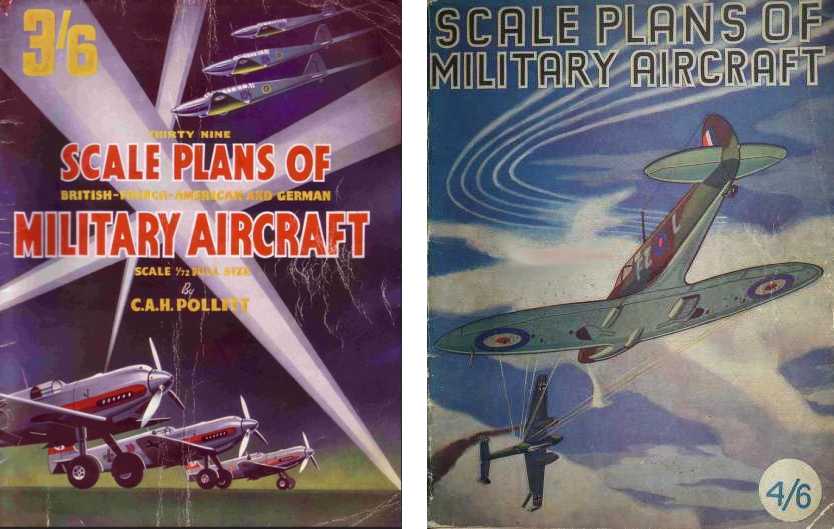
Above: Covers of the precursor and then cheaper softback contemporary of Aircraft of the Fighting Powers was Scale Plans of Military Aircraft. The early impressions had quite crude drawings but from the 6th edition they were more detailed.
Three volumes focussed on individual manufacturers:
The Book of Westland Aircraft, by AH Lukins, edited by DA Russell, Harborough, 1944
The Book of Miles Aircraft, by AH Lukins, edited by DA Russell, Harborough, 1945
The Book of Bristol Aircraft, by DA Russell, Harborough, 1946
All have 1/72 scale drawings of all aircraft built by the companies since their inception (where else would one find 1/72 plans of the enormous Bristol Braemar, Pullman, and Tramp triplanes?). The Westland book also contains 1/144 drawings of other manufacturers’ designs built by Westland. The books were sponsored by the companies concerned, with large numbers being given away to management and employees and through sales and PR departments. The books naturally presented a rather partisan view of the manufacturers and their products. The Westland and Bristol books also expressed a good deal of criticism of the Air Ministry for the rejection of some prototype aircraft. With little other reference material available for many of the aircraft described and no avenues available for the Air Ministry to refute the allegations, the books have somewhat skewed the perceived history of British military aviation development (to read more about this refer to the conclusion of my article on "The Monoplane Myth").
At some stage in the late 1940s, these later volumes started to be printed under the name of "Harleyford Publications Limited" although they often still had the "Harborough Press" logo.
The company then turned its attention to aircraft of the First World War.
Aircraft of the 1914-1918 War, by OG Thetford & EJ Riding, Harborough, 1945 (reissued 1954 by Harleyford Publications).
Fighter Aircraft of the 1914-1918 War, by WM Lamberton and EF Cheesman, Harleyford Publications, Letchworth, 1960.
Reconnaissance and Bomber Aircraft of the 1914-1918 War, by WM Lamberton and EF Cheesman, Harleyford Publications, Letchworth, 1962.
Marine Aircraft of the 1914-1918 War, by HJ Nowarra, B Robertson & PG Cooksley, Harleyford Publications, Letchworth, 1966.
Fokker - the Man and His Aircraft, by Henri Hegner, 1961
Sopwith – The Man and His Aircraft, by B Robertson, Air Review, Letchworth, 1970.
Although not a book of plans, 16 plates of colour artwork done by Rupert Moore, many of which featured in "Aircraft of the Fighting Powers" were collected in the 1945 book "Aircraft Paintings Of C. Rupert Moore, A.R.C.A", published by Harborough, with an introduction and commentary by Owen G Thetford.
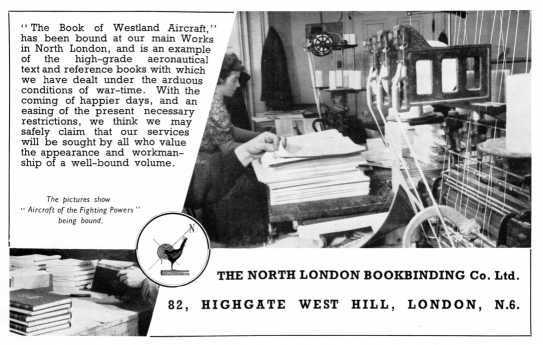
Amongst the advertisers in Harborough publications was one of the companies that did their bookbinding, quite a complex process with all those fold-out plans. During its history, at least four different companies did the printing, The Sidney Press in Bedford, Alabaster Passmore and Sons of London and Maidstone, Henderson and Spalding of London and the North London Bookbinding company.
Besides their books of plans, the company also produced other books with an aviation theme including titles on the Supermarine Spitfire, Hawker Hurricane, Messerschmitt Bf109, Focke Wulf 190 and Avro Lancaster amongst others. There were also a number of books on aircraft markings and camouflage with very impressive colour printing (in some cases including the use of metallic silver ink). Being published later, these books reached a peak resale value in the 1980s and 1990s. The books on camouflage and markings were particularly desirable and commanded prices of over £100 at their peak, but can now be picked up in good condition for less than £20.
The Aeromodeller magazine continued to publish 1/72 scale plans in the same format, many identical to those in Aircraft of the Fighting Powers, in their “Aircraft Described” and other series of articles well into the 1960s. Individual plans could also be purchased from the "Aeromodeller Plans Service" which was an offshoot of the Harborough Publishing Company.
The Aeromodeller magazine continued to publish 1/72 scale plans in the same format, many identical to those in Aircraft of the Fighting Powers, in their “Aircraft Described” and other series of articles well into the 1960s. Individual plans could also be purchased from the "Aeromodeller Plans Service" which was an offshoot of the Harborough Publishing Company.
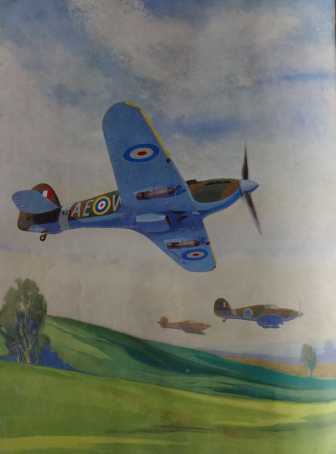
One of the colour plates in "Aircraft of the Fighting Powers", done by the artist C. Rupert Moore (Associate of the Royal College of Art). He did the artwork for the covers of Aeromodeller magazine in the 30s and 40s and also wrote articles and designed models featured in the magazine. He evolved a style and use of colour that was particularly suited to the low-quality "pulp" paper used in magazines of the time. He was a fantastic draughtsman in his own right and his plans are miniature works of art (see the fantastic plans he did of the Felixstowe flying boat for the December 1977 edition of "Scale Model" magazine) but he does not seem to have contributed plans to "Aircraft of the Fighting Powers". He also achieved success as a designer of stained-glass windows (that was his main profession), working as a designer for James Powell and Sons (Whitefriars Glass) from 1932 until about 1970. Amongst his many works are a series at Chequers, the country residence of British Prime Ministers.
If you've got extra information or stories on the production and use of "Aircraft of the Fighting Powers" I'd love to hear from you to update this page. But please DO NOT ask me for valuations or try to sell me any you have. My collection is complete.
Links
